Emergency & Trauma Care: Paediatric, Disabilities, Older Person Case
VerifiedAdded on 2023/06/03
|16
|5130
|226
Homework Assignment
AI Summary
This assignment covers three key areas of emergency and trauma care: paediatric emergencies, care for individuals with disabilities, and geriatric care. For paediatric emergencies, it discusses antipyretic therapy, fever management, and essential elements in taking a paediatric history, including pregnancy, birth, developmental, feeding, family, social, and immunization history, along with fluid and electrolyte balance. In the section on people with disabilities, it addresses communication strategies, triage considerations, recognition of specific syndromes like Fragile X, and pain assessment techniques for non-verbal patients. The final section focuses on geriatric care, presenting a case study of an elderly patient with multiple health issues, including diabetes, cardiac problems, and potential drug interactions, emphasizing the importance of cognitive assessment and appropriate hospital transport. The assignment emphasizes patient assessment, history taking, and management strategies tailored to each specific population.
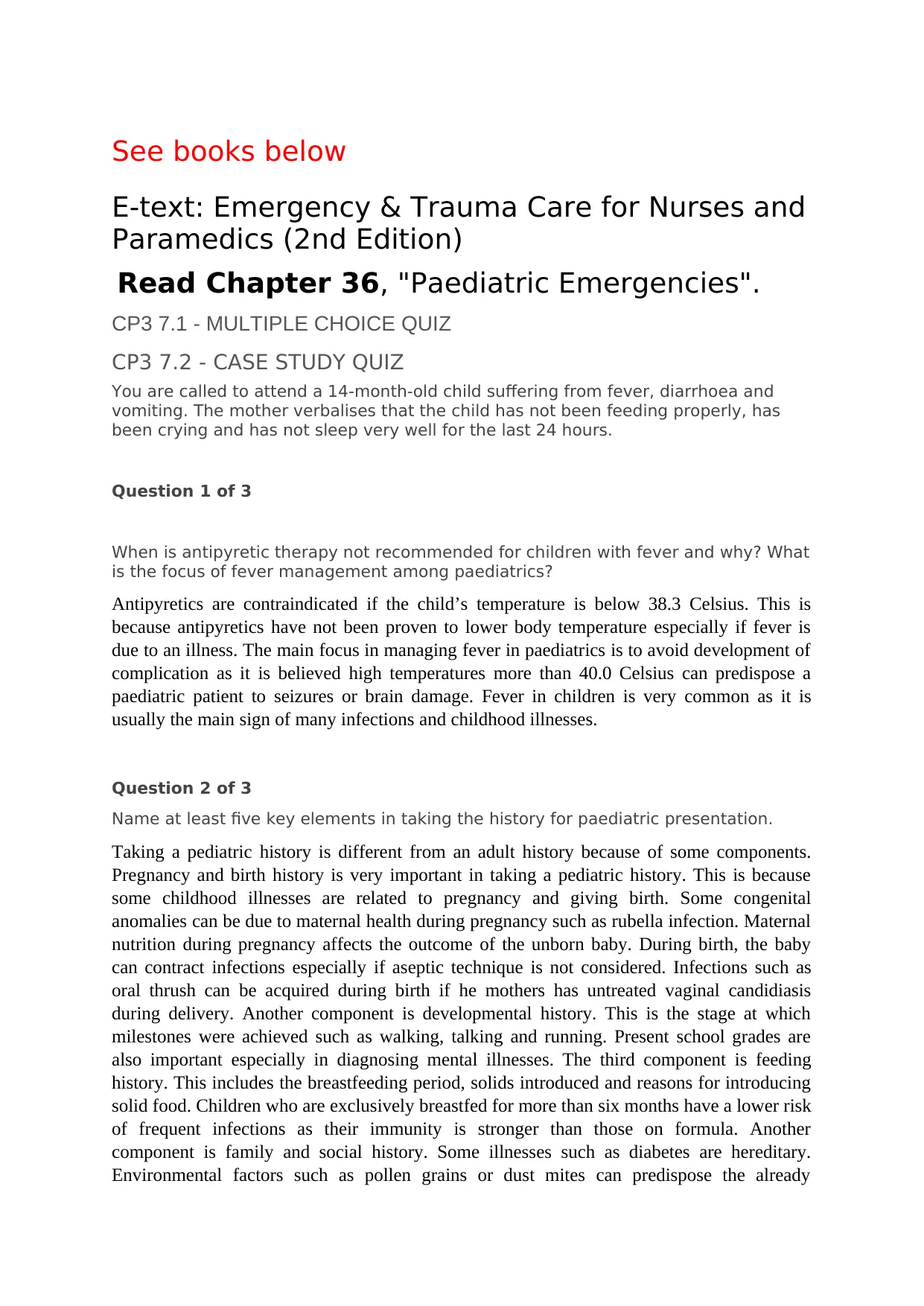
See books below
E-text: Emergency & Trauma Care for Nurses and
Paramedics (2nd Edition)
Read Chapter 36, "Paediatric Emergencies".
CP3 7.1 - MULTIPLE CHOICE QUIZ
CP3 7.2 - CASE STUDY QUIZ
You are called to attend a 14-month-old child suffering from fever, diarrhoea and
vomiting. The mother verbalises that the child has not been feeding properly, has
been crying and has not sleep very well for the last 24 hours.
Question 1 of 3
When is antipyretic therapy not recommended for children with fever and why? What
is the focus of fever management among paediatrics?
Antipyretics are contraindicated if the child’s temperature is below 38.3 Celsius. This is
because antipyretics have not been proven to lower body temperature especially if fever is
due to an illness. The main focus in managing fever in paediatrics is to avoid development of
complication as it is believed high temperatures more than 40.0 Celsius can predispose a
paediatric patient to seizures or brain damage. Fever in children is very common as it is
usually the main sign of many infections and childhood illnesses.
Question 2 of 3
Name at least five key elements in taking the history for paediatric presentation.
Taking a pediatric history is different from an adult history because of some components.
Pregnancy and birth history is very important in taking a pediatric history. This is because
some childhood illnesses are related to pregnancy and giving birth. Some congenital
anomalies can be due to maternal health during pregnancy such as rubella infection. Maternal
nutrition during pregnancy affects the outcome of the unborn baby. During birth, the baby
can contract infections especially if aseptic technique is not considered. Infections such as
oral thrush can be acquired during birth if he mothers has untreated vaginal candidiasis
during delivery. Another component is developmental history. This is the stage at which
milestones were achieved such as walking, talking and running. Present school grades are
also important especially in diagnosing mental illnesses. The third component is feeding
history. This includes the breastfeeding period, solids introduced and reasons for introducing
solid food. Children who are exclusively breastfed for more than six months have a lower risk
of frequent infections as their immunity is stronger than those on formula. Another
component is family and social history. Some illnesses such as diabetes are hereditary.
Environmental factors such as pollen grains or dust mites can predispose the already
E-text: Emergency & Trauma Care for Nurses and
Paramedics (2nd Edition)
Read Chapter 36, "Paediatric Emergencies".
CP3 7.1 - MULTIPLE CHOICE QUIZ
CP3 7.2 - CASE STUDY QUIZ
You are called to attend a 14-month-old child suffering from fever, diarrhoea and
vomiting. The mother verbalises that the child has not been feeding properly, has
been crying and has not sleep very well for the last 24 hours.
Question 1 of 3
When is antipyretic therapy not recommended for children with fever and why? What
is the focus of fever management among paediatrics?
Antipyretics are contraindicated if the child’s temperature is below 38.3 Celsius. This is
because antipyretics have not been proven to lower body temperature especially if fever is
due to an illness. The main focus in managing fever in paediatrics is to avoid development of
complication as it is believed high temperatures more than 40.0 Celsius can predispose a
paediatric patient to seizures or brain damage. Fever in children is very common as it is
usually the main sign of many infections and childhood illnesses.
Question 2 of 3
Name at least five key elements in taking the history for paediatric presentation.
Taking a pediatric history is different from an adult history because of some components.
Pregnancy and birth history is very important in taking a pediatric history. This is because
some childhood illnesses are related to pregnancy and giving birth. Some congenital
anomalies can be due to maternal health during pregnancy such as rubella infection. Maternal
nutrition during pregnancy affects the outcome of the unborn baby. During birth, the baby
can contract infections especially if aseptic technique is not considered. Infections such as
oral thrush can be acquired during birth if he mothers has untreated vaginal candidiasis
during delivery. Another component is developmental history. This is the stage at which
milestones were achieved such as walking, talking and running. Present school grades are
also important especially in diagnosing mental illnesses. The third component is feeding
history. This includes the breastfeeding period, solids introduced and reasons for introducing
solid food. Children who are exclusively breastfed for more than six months have a lower risk
of frequent infections as their immunity is stronger than those on formula. Another
component is family and social history. Some illnesses such as diabetes are hereditary.
Environmental factors such as pollen grains or dust mites can predispose the already
Paraphrase This Document
Need a fresh take? Get an instant paraphrase of this document with our AI Paraphraser
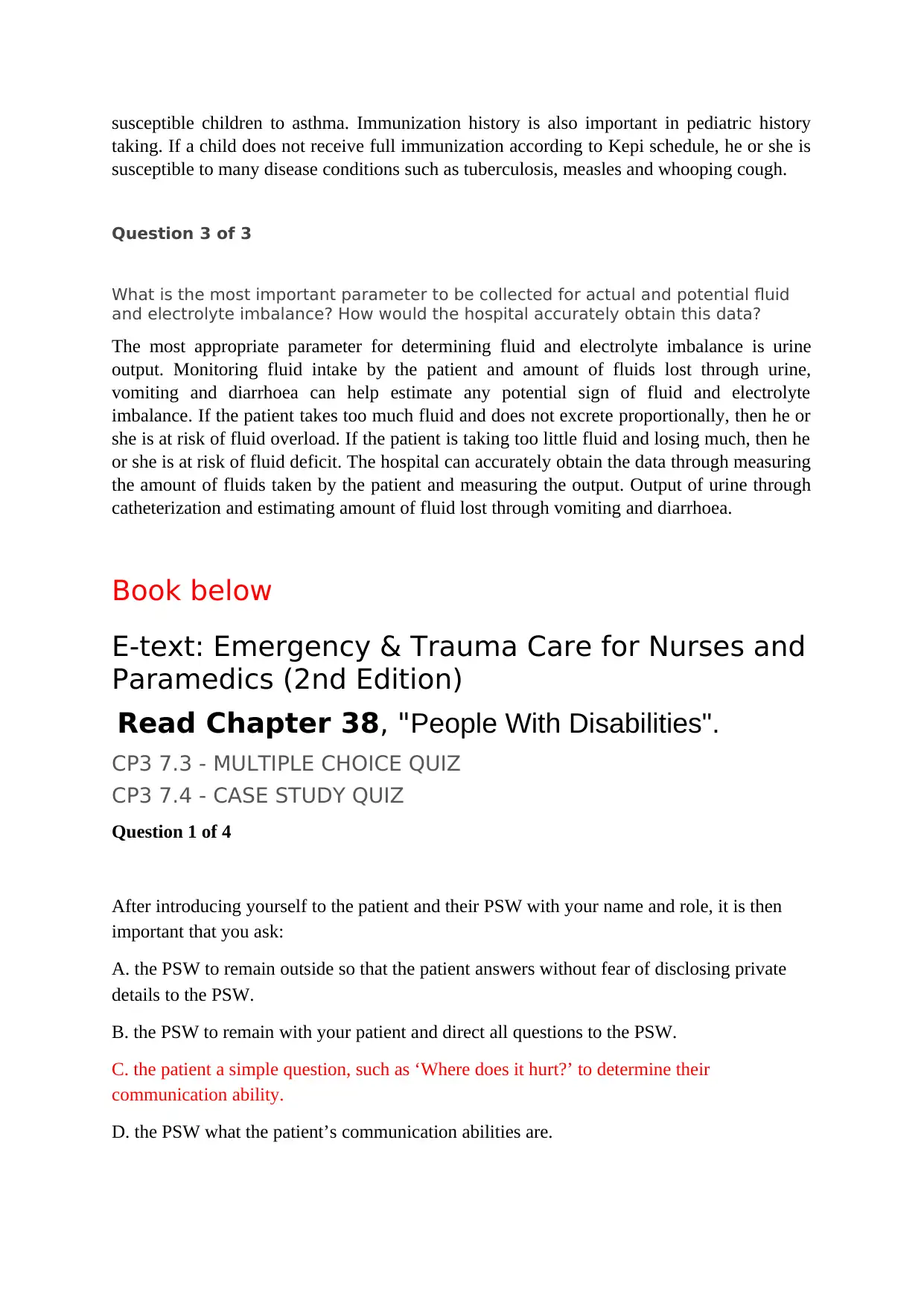
susceptible children to asthma. Immunization history is also important in pediatric history
taking. If a child does not receive full immunization according to Kepi schedule, he or she is
susceptible to many disease conditions such as tuberculosis, measles and whooping cough.
Question 3 of 3
What is the most important parameter to be collected for actual and potential fluid
and electrolyte imbalance? How would the hospital accurately obtain this data?
The most appropriate parameter for determining fluid and electrolyte imbalance is urine
output. Monitoring fluid intake by the patient and amount of fluids lost through urine,
vomiting and diarrhoea can help estimate any potential sign of fluid and electrolyte
imbalance. If the patient takes too much fluid and does not excrete proportionally, then he or
she is at risk of fluid overload. If the patient is taking too little fluid and losing much, then he
or she is at risk of fluid deficit. The hospital can accurately obtain the data through measuring
the amount of fluids taken by the patient and measuring the output. Output of urine through
catheterization and estimating amount of fluid lost through vomiting and diarrhoea.
Book below
E-text: Emergency & Trauma Care for Nurses and
Paramedics (2nd Edition)
Read Chapter 38, "People With Disabilities".
CP3 7.3 - MULTIPLE CHOICE QUIZ
CP3 7.4 - CASE STUDY QUIZ
Question 1 of 4
After introducing yourself to the patient and their PSW with your name and role, it is then
important that you ask:
A. the PSW to remain outside so that the patient answers without fear of disclosing private
details to the PSW.
B. the PSW to remain with your patient and direct all questions to the PSW.
C. the patient a simple question, such as ‘Where does it hurt?’ to determine their
communication ability.
D. the PSW what the patient’s communication abilities are.
taking. If a child does not receive full immunization according to Kepi schedule, he or she is
susceptible to many disease conditions such as tuberculosis, measles and whooping cough.
Question 3 of 3
What is the most important parameter to be collected for actual and potential fluid
and electrolyte imbalance? How would the hospital accurately obtain this data?
The most appropriate parameter for determining fluid and electrolyte imbalance is urine
output. Monitoring fluid intake by the patient and amount of fluids lost through urine,
vomiting and diarrhoea can help estimate any potential sign of fluid and electrolyte
imbalance. If the patient takes too much fluid and does not excrete proportionally, then he or
she is at risk of fluid overload. If the patient is taking too little fluid and losing much, then he
or she is at risk of fluid deficit. The hospital can accurately obtain the data through measuring
the amount of fluids taken by the patient and measuring the output. Output of urine through
catheterization and estimating amount of fluid lost through vomiting and diarrhoea.
Book below
E-text: Emergency & Trauma Care for Nurses and
Paramedics (2nd Edition)
Read Chapter 38, "People With Disabilities".
CP3 7.3 - MULTIPLE CHOICE QUIZ
CP3 7.4 - CASE STUDY QUIZ
Question 1 of 4
After introducing yourself to the patient and their PSW with your name and role, it is then
important that you ask:
A. the PSW to remain outside so that the patient answers without fear of disclosing private
details to the PSW.
B. the PSW to remain with your patient and direct all questions to the PSW.
C. the patient a simple question, such as ‘Where does it hurt?’ to determine their
communication ability.
D. the PSW what the patient’s communication abilities are.
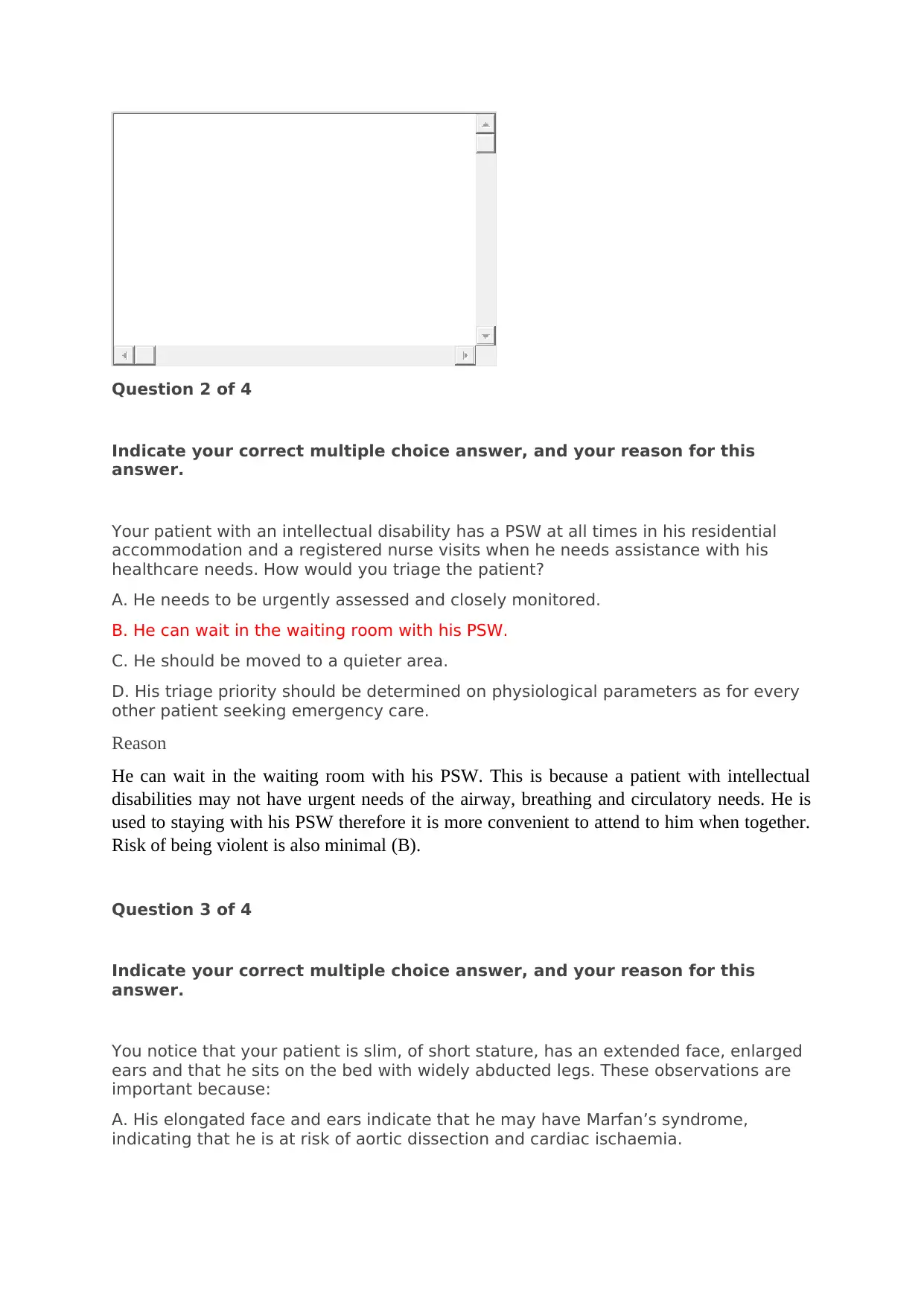
Question 2 of 4
Indicate your correct multiple choice answer, and your reason for this
answer.
Your patient with an intellectual disability has a PSW at all times in his residential
accommodation and a registered nurse visits when he needs assistance with his
healthcare needs. How would you triage the patient?
A. He needs to be urgently assessed and closely monitored.
B. He can wait in the waiting room with his PSW.
C. He should be moved to a quieter area.
D. His triage priority should be determined on physiological parameters as for every
other patient seeking emergency care.
Reason
He can wait in the waiting room with his PSW. This is because a patient with intellectual
disabilities may not have urgent needs of the airway, breathing and circulatory needs. He is
used to staying with his PSW therefore it is more convenient to attend to him when together.
Risk of being violent is also minimal (B).
Question 3 of 4
Indicate your correct multiple choice answer, and your reason for this
answer.
You notice that your patient is slim, of short stature, has an extended face, enlarged
ears and that he sits on the bed with widely abducted legs. These observations are
important because:
A. His elongated face and ears indicate that he may have Marfan’s syndrome,
indicating that he is at risk of aortic dissection and cardiac ischaemia.
Indicate your correct multiple choice answer, and your reason for this
answer.
Your patient with an intellectual disability has a PSW at all times in his residential
accommodation and a registered nurse visits when he needs assistance with his
healthcare needs. How would you triage the patient?
A. He needs to be urgently assessed and closely monitored.
B. He can wait in the waiting room with his PSW.
C. He should be moved to a quieter area.
D. His triage priority should be determined on physiological parameters as for every
other patient seeking emergency care.
Reason
He can wait in the waiting room with his PSW. This is because a patient with intellectual
disabilities may not have urgent needs of the airway, breathing and circulatory needs. He is
used to staying with his PSW therefore it is more convenient to attend to him when together.
Risk of being violent is also minimal (B).
Question 3 of 4
Indicate your correct multiple choice answer, and your reason for this
answer.
You notice that your patient is slim, of short stature, has an extended face, enlarged
ears and that he sits on the bed with widely abducted legs. These observations are
important because:
A. His elongated face and ears indicate that he may have Marfan’s syndrome,
indicating that he is at risk of aortic dissection and cardiac ischaemia.
⊘ This is a preview!⊘
Do you want full access?
Subscribe today to unlock all pages.

Trusted by 1+ million students worldwide
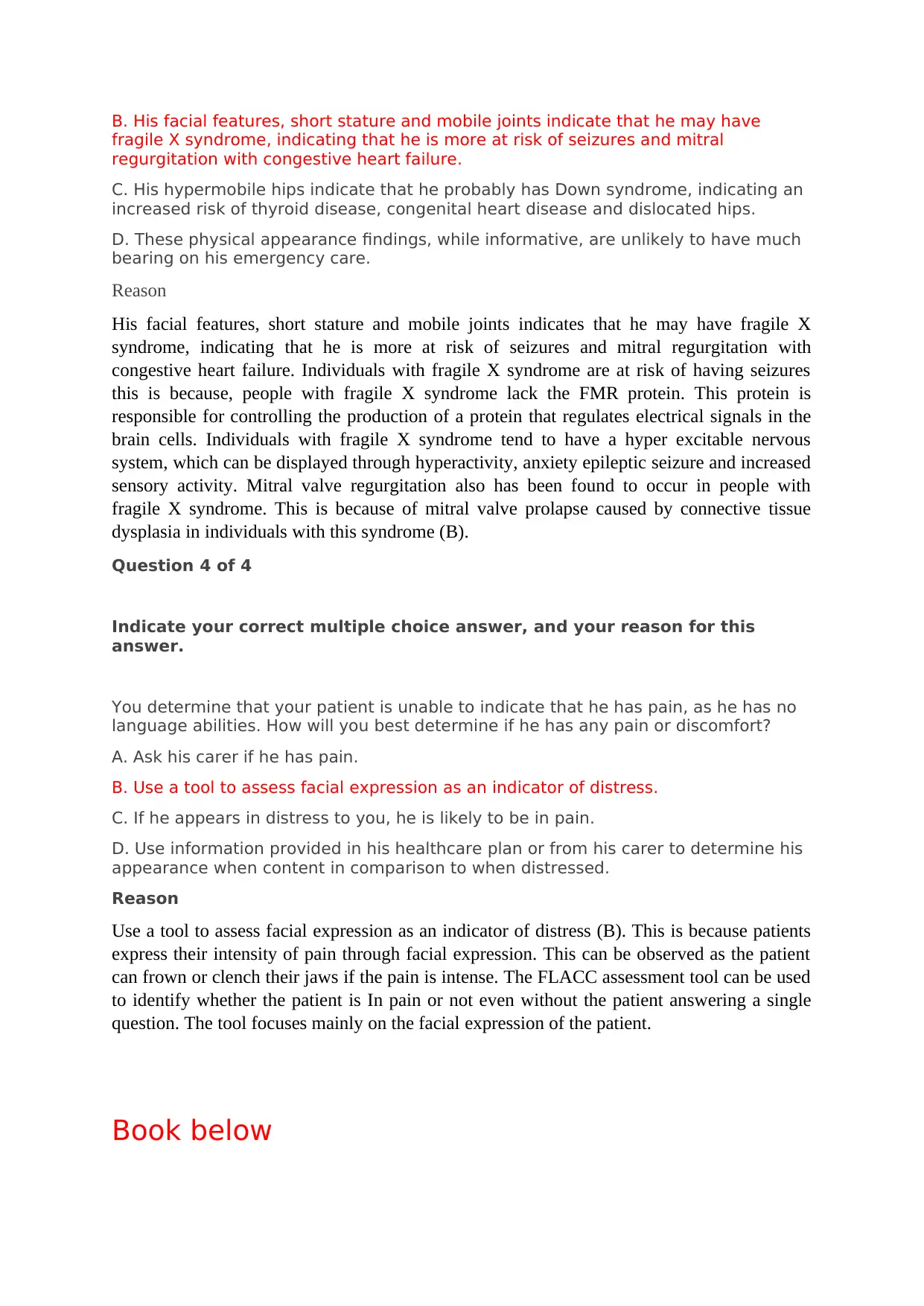
B. His facial features, short stature and mobile joints indicate that he may have
fragile X syndrome, indicating that he is more at risk of seizures and mitral
regurgitation with congestive heart failure.
C. His hypermobile hips indicate that he probably has Down syndrome, indicating an
increased risk of thyroid disease, congenital heart disease and dislocated hips.
D. These physical appearance findings, while informative, are unlikely to have much
bearing on his emergency care.
Reason
His facial features, short stature and mobile joints indicates that he may have fragile X
syndrome, indicating that he is more at risk of seizures and mitral regurgitation with
congestive heart failure. Individuals with fragile X syndrome are at risk of having seizures
this is because, people with fragile X syndrome lack the FMR protein. This protein is
responsible for controlling the production of a protein that regulates electrical signals in the
brain cells. Individuals with fragile X syndrome tend to have a hyper excitable nervous
system, which can be displayed through hyperactivity, anxiety epileptic seizure and increased
sensory activity. Mitral valve regurgitation also has been found to occur in people with
fragile X syndrome. This is because of mitral valve prolapse caused by connective tissue
dysplasia in individuals with this syndrome (B).
Question 4 of 4
Indicate your correct multiple choice answer, and your reason for this
answer.
You determine that your patient is unable to indicate that he has pain, as he has no
language abilities. How will you best determine if he has any pain or discomfort?
A. Ask his carer if he has pain.
B. Use a tool to assess facial expression as an indicator of distress.
C. If he appears in distress to you, he is likely to be in pain.
D. Use information provided in his healthcare plan or from his carer to determine his
appearance when content in comparison to when distressed.
Reason
Use a tool to assess facial expression as an indicator of distress (B). This is because patients
express their intensity of pain through facial expression. This can be observed as the patient
can frown or clench their jaws if the pain is intense. The FLACC assessment tool can be used
to identify whether the patient is In pain or not even without the patient answering a single
question. The tool focuses mainly on the facial expression of the patient.
Book below
fragile X syndrome, indicating that he is more at risk of seizures and mitral
regurgitation with congestive heart failure.
C. His hypermobile hips indicate that he probably has Down syndrome, indicating an
increased risk of thyroid disease, congenital heart disease and dislocated hips.
D. These physical appearance findings, while informative, are unlikely to have much
bearing on his emergency care.
Reason
His facial features, short stature and mobile joints indicates that he may have fragile X
syndrome, indicating that he is more at risk of seizures and mitral regurgitation with
congestive heart failure. Individuals with fragile X syndrome are at risk of having seizures
this is because, people with fragile X syndrome lack the FMR protein. This protein is
responsible for controlling the production of a protein that regulates electrical signals in the
brain cells. Individuals with fragile X syndrome tend to have a hyper excitable nervous
system, which can be displayed through hyperactivity, anxiety epileptic seizure and increased
sensory activity. Mitral valve regurgitation also has been found to occur in people with
fragile X syndrome. This is because of mitral valve prolapse caused by connective tissue
dysplasia in individuals with this syndrome (B).
Question 4 of 4
Indicate your correct multiple choice answer, and your reason for this
answer.
You determine that your patient is unable to indicate that he has pain, as he has no
language abilities. How will you best determine if he has any pain or discomfort?
A. Ask his carer if he has pain.
B. Use a tool to assess facial expression as an indicator of distress.
C. If he appears in distress to you, he is likely to be in pain.
D. Use information provided in his healthcare plan or from his carer to determine his
appearance when content in comparison to when distressed.
Reason
Use a tool to assess facial expression as an indicator of distress (B). This is because patients
express their intensity of pain through facial expression. This can be observed as the patient
can frown or clench their jaws if the pain is intense. The FLACC assessment tool can be used
to identify whether the patient is In pain or not even without the patient answering a single
question. The tool focuses mainly on the facial expression of the patient.
Book below
Paraphrase This Document
Need a fresh take? Get an instant paraphrase of this document with our AI Paraphraser
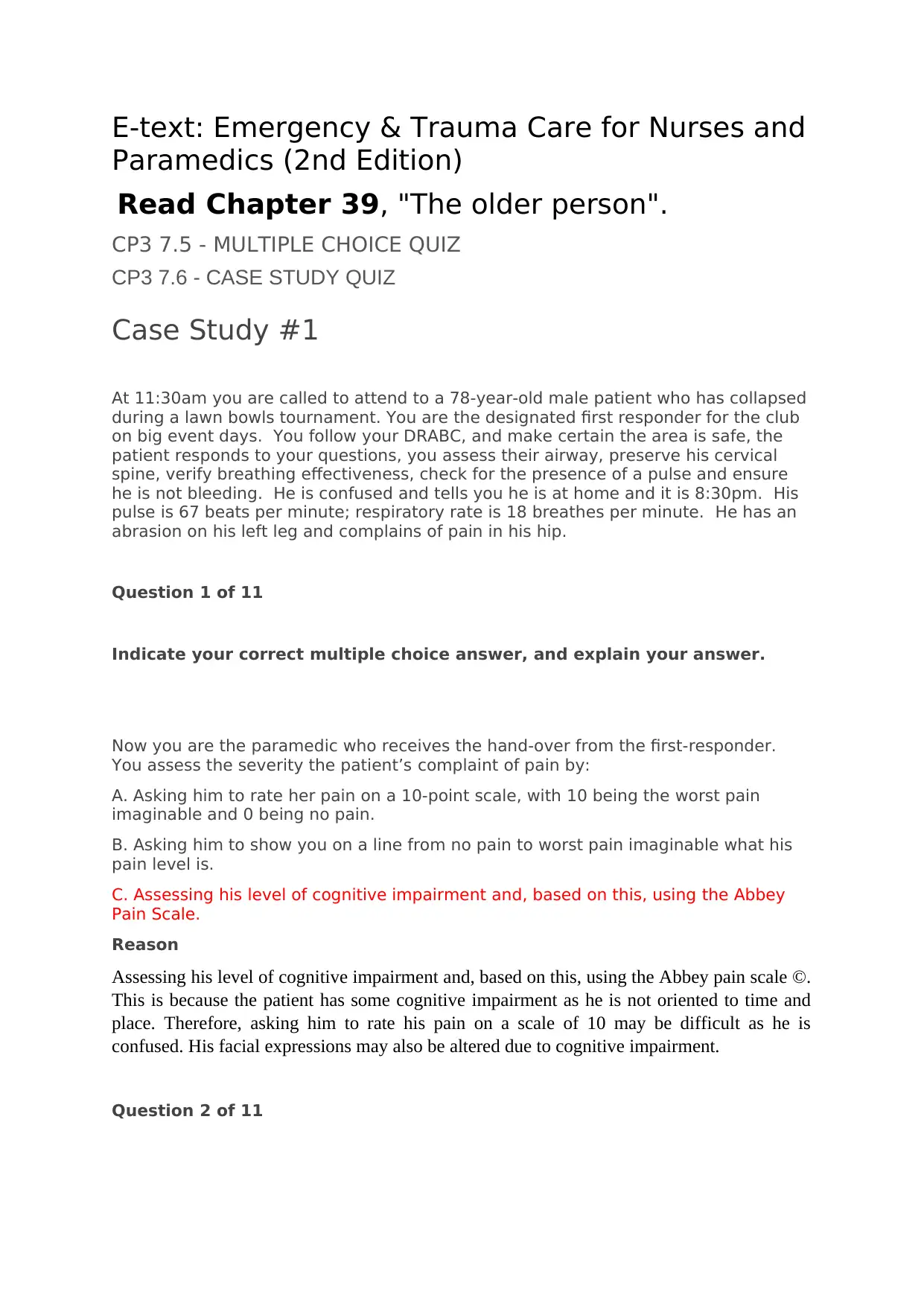
E-text: Emergency & Trauma Care for Nurses and
Paramedics (2nd Edition)
Read Chapter 39, "The older person".
CP3 7.5 - MULTIPLE CHOICE QUIZ
CP3 7.6 - CASE STUDY QUIZ
Case Study #1
At 11:30am you are called to attend to a 78-year-old male patient who has collapsed
during a lawn bowls tournament. You are the designated first responder for the club
on big event days. You follow your DRABC, and make certain the area is safe, the
patient responds to your questions, you assess their airway, preserve his cervical
spine, verify breathing effectiveness, check for the presence of a pulse and ensure
he is not bleeding. He is confused and tells you he is at home and it is 8:30pm. His
pulse is 67 beats per minute; respiratory rate is 18 breathes per minute. He has an
abrasion on his left leg and complains of pain in his hip.
Question 1 of 11
Indicate your correct multiple choice answer, and explain your answer.
Now you are the paramedic who receives the hand-over from the first-responder.
You assess the severity the patient’s complaint of pain by:
A. Asking him to rate her pain on a 10-point scale, with 10 being the worst pain
imaginable and 0 being no pain.
B. Asking him to show you on a line from no pain to worst pain imaginable what his
pain level is.
C. Assessing his level of cognitive impairment and, based on this, using the Abbey
Pain Scale.
Reason
Assessing his level of cognitive impairment and, based on this, using the Abbey pain scale ©.
This is because the patient has some cognitive impairment as he is not oriented to time and
place. Therefore, asking him to rate his pain on a scale of 10 may be difficult as he is
confused. His facial expressions may also be altered due to cognitive impairment.
Question 2 of 11
Paramedics (2nd Edition)
Read Chapter 39, "The older person".
CP3 7.5 - MULTIPLE CHOICE QUIZ
CP3 7.6 - CASE STUDY QUIZ
Case Study #1
At 11:30am you are called to attend to a 78-year-old male patient who has collapsed
during a lawn bowls tournament. You are the designated first responder for the club
on big event days. You follow your DRABC, and make certain the area is safe, the
patient responds to your questions, you assess their airway, preserve his cervical
spine, verify breathing effectiveness, check for the presence of a pulse and ensure
he is not bleeding. He is confused and tells you he is at home and it is 8:30pm. His
pulse is 67 beats per minute; respiratory rate is 18 breathes per minute. He has an
abrasion on his left leg and complains of pain in his hip.
Question 1 of 11
Indicate your correct multiple choice answer, and explain your answer.
Now you are the paramedic who receives the hand-over from the first-responder.
You assess the severity the patient’s complaint of pain by:
A. Asking him to rate her pain on a 10-point scale, with 10 being the worst pain
imaginable and 0 being no pain.
B. Asking him to show you on a line from no pain to worst pain imaginable what his
pain level is.
C. Assessing his level of cognitive impairment and, based on this, using the Abbey
Pain Scale.
Reason
Assessing his level of cognitive impairment and, based on this, using the Abbey pain scale ©.
This is because the patient has some cognitive impairment as he is not oriented to time and
place. Therefore, asking him to rate his pain on a scale of 10 may be difficult as he is
confused. His facial expressions may also be altered due to cognitive impairment.
Question 2 of 11
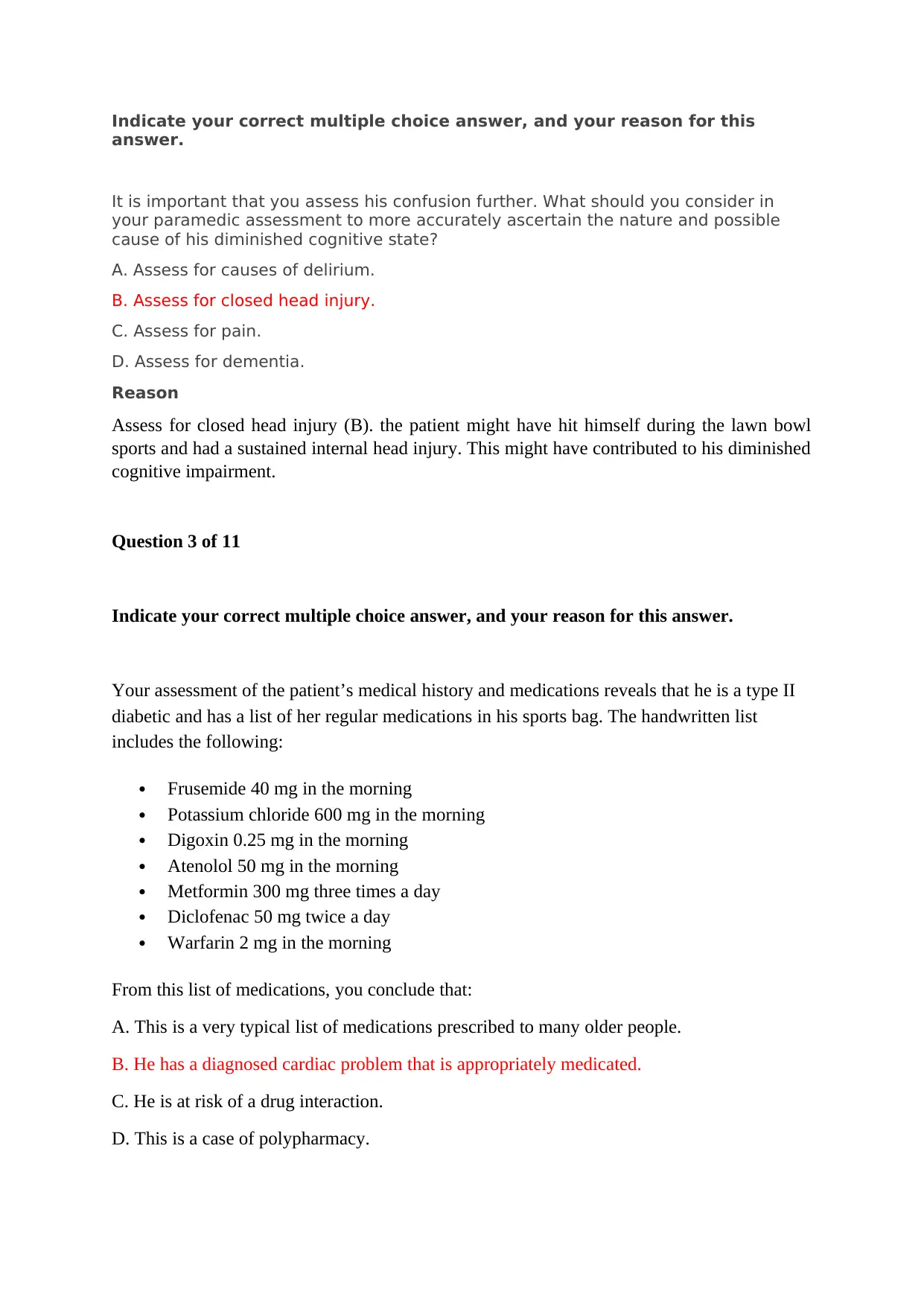
Indicate your correct multiple choice answer, and your reason for this
answer.
It is important that you assess his confusion further. What should you consider in
your paramedic assessment to more accurately ascertain the nature and possible
cause of his diminished cognitive state?
A. Assess for causes of delirium.
B. Assess for closed head injury.
C. Assess for pain.
D. Assess for dementia.
Reason
Assess for closed head injury (B). the patient might have hit himself during the lawn bowl
sports and had a sustained internal head injury. This might have contributed to his diminished
cognitive impairment.
Question 3 of 11
Indicate your correct multiple choice answer, and your reason for this answer.
Your assessment of the patient’s medical history and medications reveals that he is a type II
diabetic and has a list of her regular medications in his sports bag. The handwritten list
includes the following:
Frusemide 40 mg in the morning
Potassium chloride 600 mg in the morning
Digoxin 0.25 mg in the morning
Atenolol 50 mg in the morning
Metformin 300 mg three times a day
Diclofenac 50 mg twice a day
Warfarin 2 mg in the morning
From this list of medications, you conclude that:
A. This is a very typical list of medications prescribed to many older people.
B. He has a diagnosed cardiac problem that is appropriately medicated.
C. He is at risk of a drug interaction.
D. This is a case of polypharmacy.
answer.
It is important that you assess his confusion further. What should you consider in
your paramedic assessment to more accurately ascertain the nature and possible
cause of his diminished cognitive state?
A. Assess for causes of delirium.
B. Assess for closed head injury.
C. Assess for pain.
D. Assess for dementia.
Reason
Assess for closed head injury (B). the patient might have hit himself during the lawn bowl
sports and had a sustained internal head injury. This might have contributed to his diminished
cognitive impairment.
Question 3 of 11
Indicate your correct multiple choice answer, and your reason for this answer.
Your assessment of the patient’s medical history and medications reveals that he is a type II
diabetic and has a list of her regular medications in his sports bag. The handwritten list
includes the following:
Frusemide 40 mg in the morning
Potassium chloride 600 mg in the morning
Digoxin 0.25 mg in the morning
Atenolol 50 mg in the morning
Metformin 300 mg three times a day
Diclofenac 50 mg twice a day
Warfarin 2 mg in the morning
From this list of medications, you conclude that:
A. This is a very typical list of medications prescribed to many older people.
B. He has a diagnosed cardiac problem that is appropriately medicated.
C. He is at risk of a drug interaction.
D. This is a case of polypharmacy.
⊘ This is a preview!⊘
Do you want full access?
Subscribe today to unlock all pages.

Trusted by 1+ million students worldwide
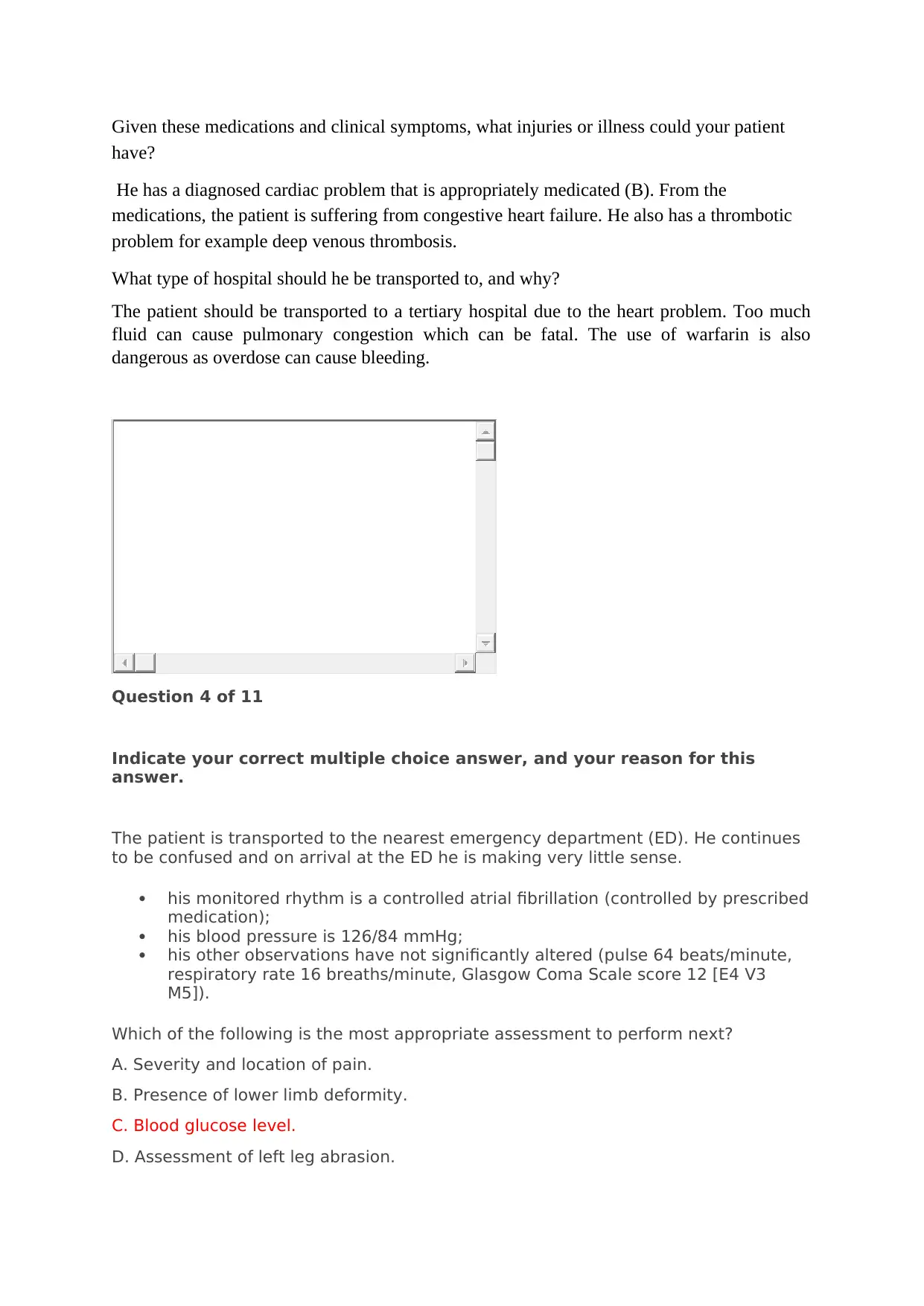
Given these medications and clinical symptoms, what injuries or illness could your patient
have?
He has a diagnosed cardiac problem that is appropriately medicated (B). From the
medications, the patient is suffering from congestive heart failure. He also has a thrombotic
problem for example deep venous thrombosis.
What type of hospital should he be transported to, and why?
The patient should be transported to a tertiary hospital due to the heart problem. Too much
fluid can cause pulmonary congestion which can be fatal. The use of warfarin is also
dangerous as overdose can cause bleeding.
Question 4 of 11
Indicate your correct multiple choice answer, and your reason for this
answer.
The patient is transported to the nearest emergency department (ED). He continues
to be confused and on arrival at the ED he is making very little sense.
his monitored rhythm is a controlled atrial fibrillation (controlled by prescribed
medication);
his blood pressure is 126/84 mmHg;
his other observations have not significantly altered (pulse 64 beats/minute,
respiratory rate 16 breaths/minute, Glasgow Coma Scale score 12 [E4 V3
M5]).
Which of the following is the most appropriate assessment to perform next?
A. Severity and location of pain.
B. Presence of lower limb deformity.
C. Blood glucose level.
D. Assessment of left leg abrasion.
have?
He has a diagnosed cardiac problem that is appropriately medicated (B). From the
medications, the patient is suffering from congestive heart failure. He also has a thrombotic
problem for example deep venous thrombosis.
What type of hospital should he be transported to, and why?
The patient should be transported to a tertiary hospital due to the heart problem. Too much
fluid can cause pulmonary congestion which can be fatal. The use of warfarin is also
dangerous as overdose can cause bleeding.
Question 4 of 11
Indicate your correct multiple choice answer, and your reason for this
answer.
The patient is transported to the nearest emergency department (ED). He continues
to be confused and on arrival at the ED he is making very little sense.
his monitored rhythm is a controlled atrial fibrillation (controlled by prescribed
medication);
his blood pressure is 126/84 mmHg;
his other observations have not significantly altered (pulse 64 beats/minute,
respiratory rate 16 breaths/minute, Glasgow Coma Scale score 12 [E4 V3
M5]).
Which of the following is the most appropriate assessment to perform next?
A. Severity and location of pain.
B. Presence of lower limb deformity.
C. Blood glucose level.
D. Assessment of left leg abrasion.
Paraphrase This Document
Need a fresh take? Get an instant paraphrase of this document with our AI Paraphraser
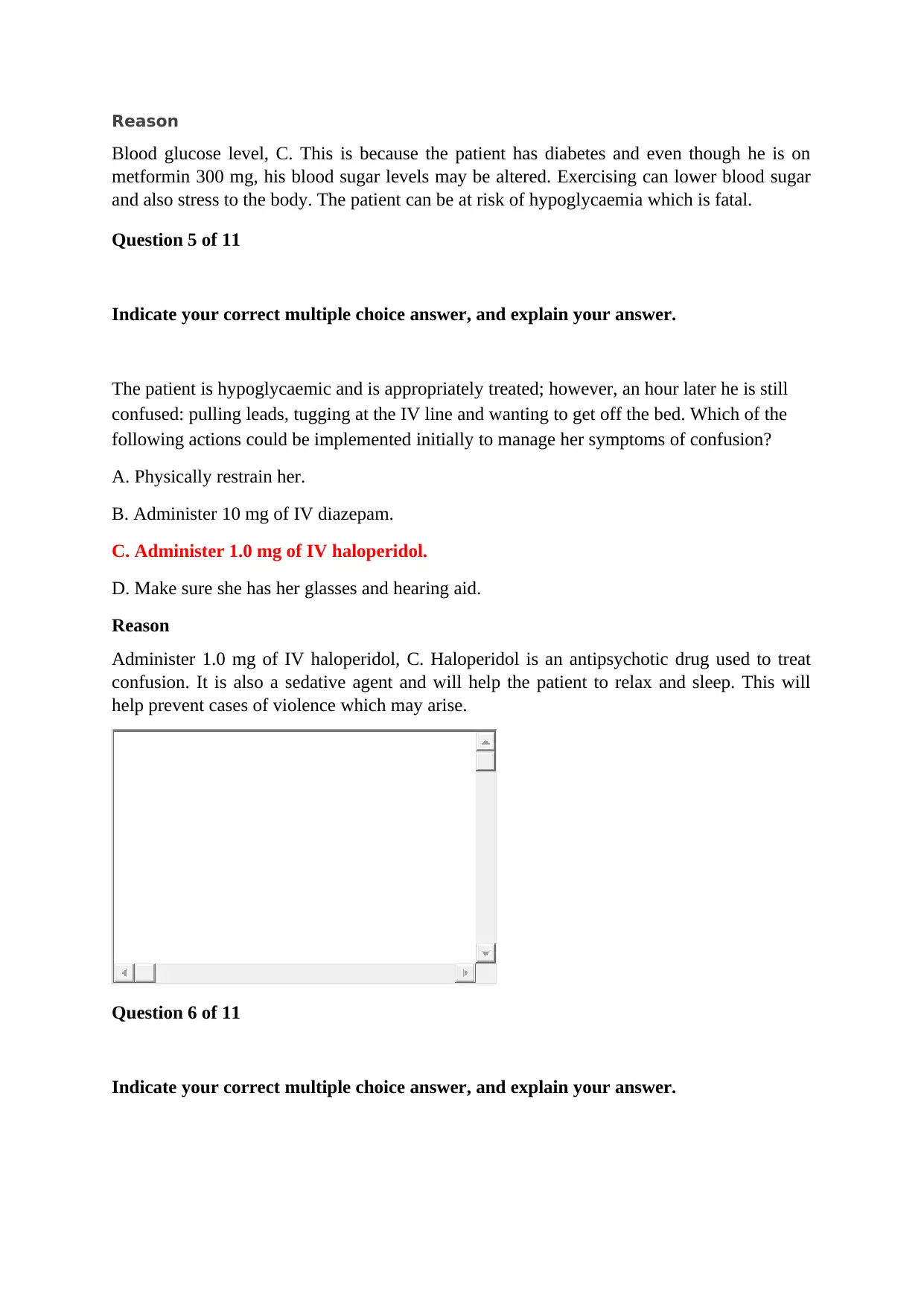
Reason
Blood glucose level, C. This is because the patient has diabetes and even though he is on
metformin 300 mg, his blood sugar levels may be altered. Exercising can lower blood sugar
and also stress to the body. The patient can be at risk of hypoglycaemia which is fatal.
Question 5 of 11
Indicate your correct multiple choice answer, and explain your answer.
The patient is hypoglycaemic and is appropriately treated; however, an hour later he is still
confused: pulling leads, tugging at the IV line and wanting to get off the bed. Which of the
following actions could be implemented initially to manage her symptoms of confusion?
A. Physically restrain her.
B. Administer 10 mg of IV diazepam.
C. Administer 1.0 mg of IV haloperidol.
D. Make sure she has her glasses and hearing aid.
Reason
Administer 1.0 mg of IV haloperidol, C. Haloperidol is an antipsychotic drug used to treat
confusion. It is also a sedative agent and will help the patient to relax and sleep. This will
help prevent cases of violence which may arise.
Question 6 of 11
Indicate your correct multiple choice answer, and explain your answer.
Blood glucose level, C. This is because the patient has diabetes and even though he is on
metformin 300 mg, his blood sugar levels may be altered. Exercising can lower blood sugar
and also stress to the body. The patient can be at risk of hypoglycaemia which is fatal.
Question 5 of 11
Indicate your correct multiple choice answer, and explain your answer.
The patient is hypoglycaemic and is appropriately treated; however, an hour later he is still
confused: pulling leads, tugging at the IV line and wanting to get off the bed. Which of the
following actions could be implemented initially to manage her symptoms of confusion?
A. Physically restrain her.
B. Administer 10 mg of IV diazepam.
C. Administer 1.0 mg of IV haloperidol.
D. Make sure she has her glasses and hearing aid.
Reason
Administer 1.0 mg of IV haloperidol, C. Haloperidol is an antipsychotic drug used to treat
confusion. It is also a sedative agent and will help the patient to relax and sleep. This will
help prevent cases of violence which may arise.
Question 6 of 11
Indicate your correct multiple choice answer, and explain your answer.
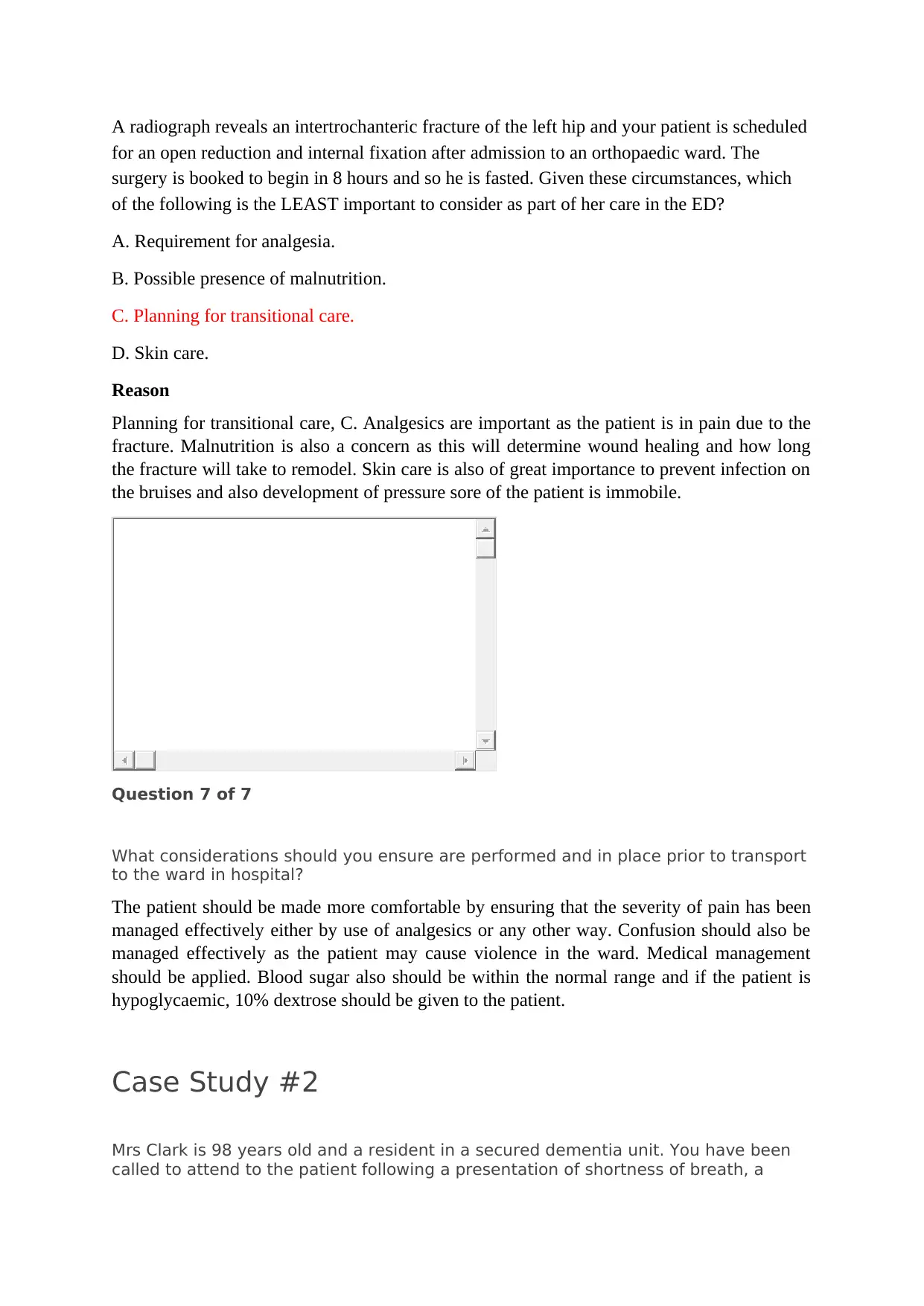
A radiograph reveals an intertrochanteric fracture of the left hip and your patient is scheduled
for an open reduction and internal fixation after admission to an orthopaedic ward. The
surgery is booked to begin in 8 hours and so he is fasted. Given these circumstances, which
of the following is the LEAST important to consider as part of her care in the ED?
A. Requirement for analgesia.
B. Possible presence of malnutrition.
C. Planning for transitional care.
D. Skin care.
Reason
Planning for transitional care, C. Analgesics are important as the patient is in pain due to the
fracture. Malnutrition is also a concern as this will determine wound healing and how long
the fracture will take to remodel. Skin care is also of great importance to prevent infection on
the bruises and also development of pressure sore of the patient is immobile.
Question 7 of 7
What considerations should you ensure are performed and in place prior to transport
to the ward in hospital?
The patient should be made more comfortable by ensuring that the severity of pain has been
managed effectively either by use of analgesics or any other way. Confusion should also be
managed effectively as the patient may cause violence in the ward. Medical management
should be applied. Blood sugar also should be within the normal range and if the patient is
hypoglycaemic, 10% dextrose should be given to the patient.
Case Study #2
Mrs Clark is 98 years old and a resident in a secured dementia unit. You have been
called to attend to the patient following a presentation of shortness of breath, a
for an open reduction and internal fixation after admission to an orthopaedic ward. The
surgery is booked to begin in 8 hours and so he is fasted. Given these circumstances, which
of the following is the LEAST important to consider as part of her care in the ED?
A. Requirement for analgesia.
B. Possible presence of malnutrition.
C. Planning for transitional care.
D. Skin care.
Reason
Planning for transitional care, C. Analgesics are important as the patient is in pain due to the
fracture. Malnutrition is also a concern as this will determine wound healing and how long
the fracture will take to remodel. Skin care is also of great importance to prevent infection on
the bruises and also development of pressure sore of the patient is immobile.
Question 7 of 7
What considerations should you ensure are performed and in place prior to transport
to the ward in hospital?
The patient should be made more comfortable by ensuring that the severity of pain has been
managed effectively either by use of analgesics or any other way. Confusion should also be
managed effectively as the patient may cause violence in the ward. Medical management
should be applied. Blood sugar also should be within the normal range and if the patient is
hypoglycaemic, 10% dextrose should be given to the patient.
Case Study #2
Mrs Clark is 98 years old and a resident in a secured dementia unit. You have been
called to attend to the patient following a presentation of shortness of breath, a
⊘ This is a preview!⊘
Do you want full access?
Subscribe today to unlock all pages.

Trusted by 1+ million students worldwide
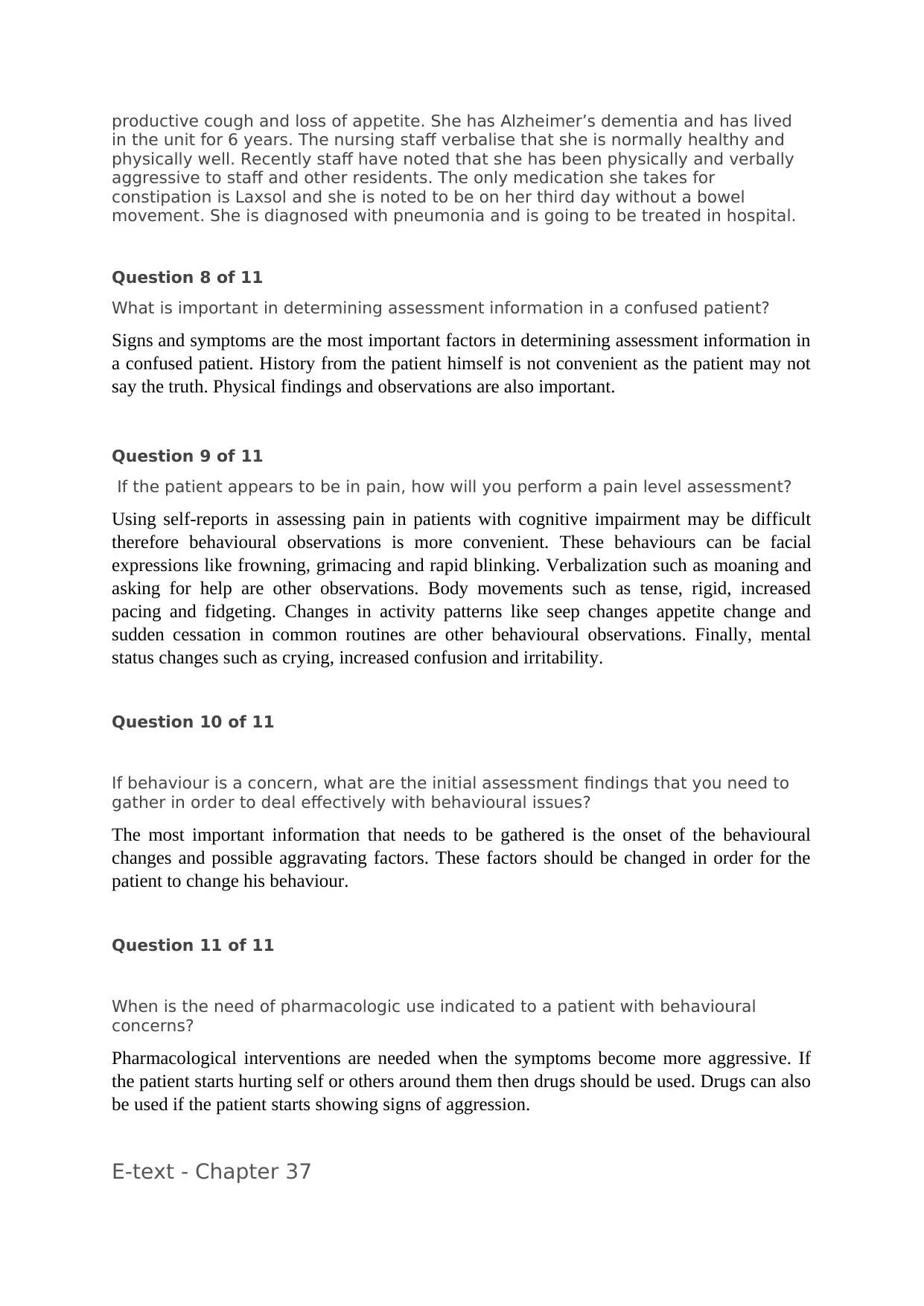
productive cough and loss of appetite. She has Alzheimer’s dementia and has lived
in the unit for 6 years. The nursing staff verbalise that she is normally healthy and
physically well. Recently staff have noted that she has been physically and verbally
aggressive to staff and other residents. The only medication she takes for
constipation is Laxsol and she is noted to be on her third day without a bowel
movement. She is diagnosed with pneumonia and is going to be treated in hospital.
Question 8 of 11
What is important in determining assessment information in a confused patient?
Signs and symptoms are the most important factors in determining assessment information in
a confused patient. History from the patient himself is not convenient as the patient may not
say the truth. Physical findings and observations are also important.
Question 9 of 11
If the patient appears to be in pain, how will you perform a pain level assessment?
Using self-reports in assessing pain in patients with cognitive impairment may be difficult
therefore behavioural observations is more convenient. These behaviours can be facial
expressions like frowning, grimacing and rapid blinking. Verbalization such as moaning and
asking for help are other observations. Body movements such as tense, rigid, increased
pacing and fidgeting. Changes in activity patterns like seep changes appetite change and
sudden cessation in common routines are other behavioural observations. Finally, mental
status changes such as crying, increased confusion and irritability.
Question 10 of 11
If behaviour is a concern, what are the initial assessment findings that you need to
gather in order to deal effectively with behavioural issues?
The most important information that needs to be gathered is the onset of the behavioural
changes and possible aggravating factors. These factors should be changed in order for the
patient to change his behaviour.
Question 11 of 11
When is the need of pharmacologic use indicated to a patient with behavioural
concerns?
Pharmacological interventions are needed when the symptoms become more aggressive. If
the patient starts hurting self or others around them then drugs should be used. Drugs can also
be used if the patient starts showing signs of aggression.
E-text - Chapter 37
in the unit for 6 years. The nursing staff verbalise that she is normally healthy and
physically well. Recently staff have noted that she has been physically and verbally
aggressive to staff and other residents. The only medication she takes for
constipation is Laxsol and she is noted to be on her third day without a bowel
movement. She is diagnosed with pneumonia and is going to be treated in hospital.
Question 8 of 11
What is important in determining assessment information in a confused patient?
Signs and symptoms are the most important factors in determining assessment information in
a confused patient. History from the patient himself is not convenient as the patient may not
say the truth. Physical findings and observations are also important.
Question 9 of 11
If the patient appears to be in pain, how will you perform a pain level assessment?
Using self-reports in assessing pain in patients with cognitive impairment may be difficult
therefore behavioural observations is more convenient. These behaviours can be facial
expressions like frowning, grimacing and rapid blinking. Verbalization such as moaning and
asking for help are other observations. Body movements such as tense, rigid, increased
pacing and fidgeting. Changes in activity patterns like seep changes appetite change and
sudden cessation in common routines are other behavioural observations. Finally, mental
status changes such as crying, increased confusion and irritability.
Question 10 of 11
If behaviour is a concern, what are the initial assessment findings that you need to
gather in order to deal effectively with behavioural issues?
The most important information that needs to be gathered is the onset of the behavioural
changes and possible aggravating factors. These factors should be changed in order for the
patient to change his behaviour.
Question 11 of 11
When is the need of pharmacologic use indicated to a patient with behavioural
concerns?
Pharmacological interventions are needed when the symptoms become more aggressive. If
the patient starts hurting self or others around them then drugs should be used. Drugs can also
be used if the patient starts showing signs of aggression.
E-text - Chapter 37
Paraphrase This Document
Need a fresh take? Get an instant paraphrase of this document with our AI Paraphraser
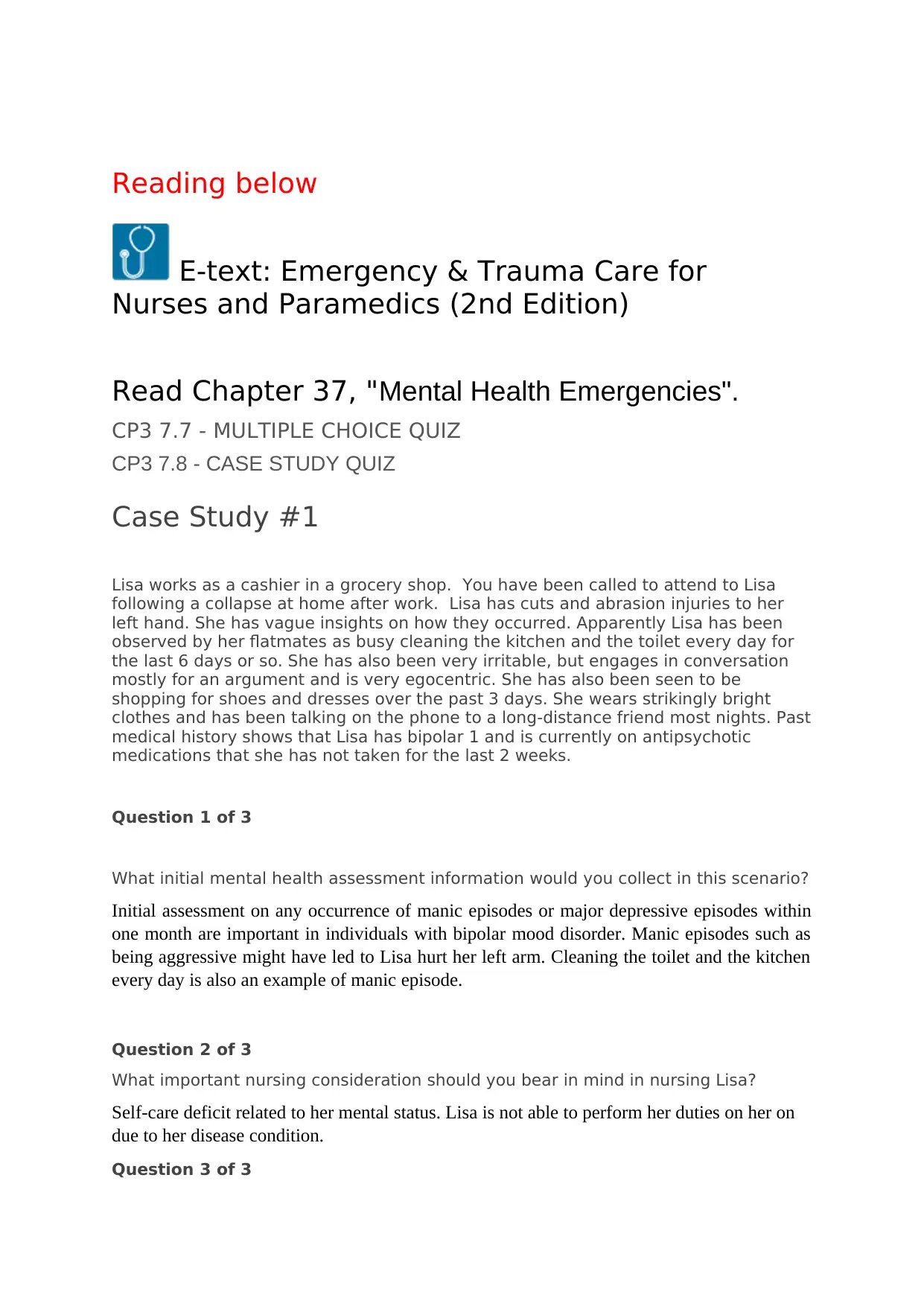
Reading below
E-text: Emergency & Trauma Care for
Nurses and Paramedics (2nd Edition)
Read Chapter 37, "Mental Health Emergencies".
CP3 7.7 - MULTIPLE CHOICE QUIZ
CP3 7.8 - CASE STUDY QUIZ
Case Study #1
Lisa works as a cashier in a grocery shop. You have been called to attend to Lisa
following a collapse at home after work. Lisa has cuts and abrasion injuries to her
left hand. She has vague insights on how they occurred. Apparently Lisa has been
observed by her flatmates as busy cleaning the kitchen and the toilet every day for
the last 6 days or so. She has also been very irritable, but engages in conversation
mostly for an argument and is very egocentric. She has also been seen to be
shopping for shoes and dresses over the past 3 days. She wears strikingly bright
clothes and has been talking on the phone to a long-distance friend most nights. Past
medical history shows that Lisa has bipolar 1 and is currently on antipsychotic
medications that she has not taken for the last 2 weeks.
Question 1 of 3
What initial mental health assessment information would you collect in this scenario?
Initial assessment on any occurrence of manic episodes or major depressive episodes within
one month are important in individuals with bipolar mood disorder. Manic episodes such as
being aggressive might have led to Lisa hurt her left arm. Cleaning the toilet and the kitchen
every day is also an example of manic episode.
Question 2 of 3
What important nursing consideration should you bear in mind in nursing Lisa?
Self-care deficit related to her mental status. Lisa is not able to perform her duties on her on
due to her disease condition.
Question 3 of 3
E-text: Emergency & Trauma Care for
Nurses and Paramedics (2nd Edition)
Read Chapter 37, "Mental Health Emergencies".
CP3 7.7 - MULTIPLE CHOICE QUIZ
CP3 7.8 - CASE STUDY QUIZ
Case Study #1
Lisa works as a cashier in a grocery shop. You have been called to attend to Lisa
following a collapse at home after work. Lisa has cuts and abrasion injuries to her
left hand. She has vague insights on how they occurred. Apparently Lisa has been
observed by her flatmates as busy cleaning the kitchen and the toilet every day for
the last 6 days or so. She has also been very irritable, but engages in conversation
mostly for an argument and is very egocentric. She has also been seen to be
shopping for shoes and dresses over the past 3 days. She wears strikingly bright
clothes and has been talking on the phone to a long-distance friend most nights. Past
medical history shows that Lisa has bipolar 1 and is currently on antipsychotic
medications that she has not taken for the last 2 weeks.
Question 1 of 3
What initial mental health assessment information would you collect in this scenario?
Initial assessment on any occurrence of manic episodes or major depressive episodes within
one month are important in individuals with bipolar mood disorder. Manic episodes such as
being aggressive might have led to Lisa hurt her left arm. Cleaning the toilet and the kitchen
every day is also an example of manic episode.
Question 2 of 3
What important nursing consideration should you bear in mind in nursing Lisa?
Self-care deficit related to her mental status. Lisa is not able to perform her duties on her on
due to her disease condition.
Question 3 of 3
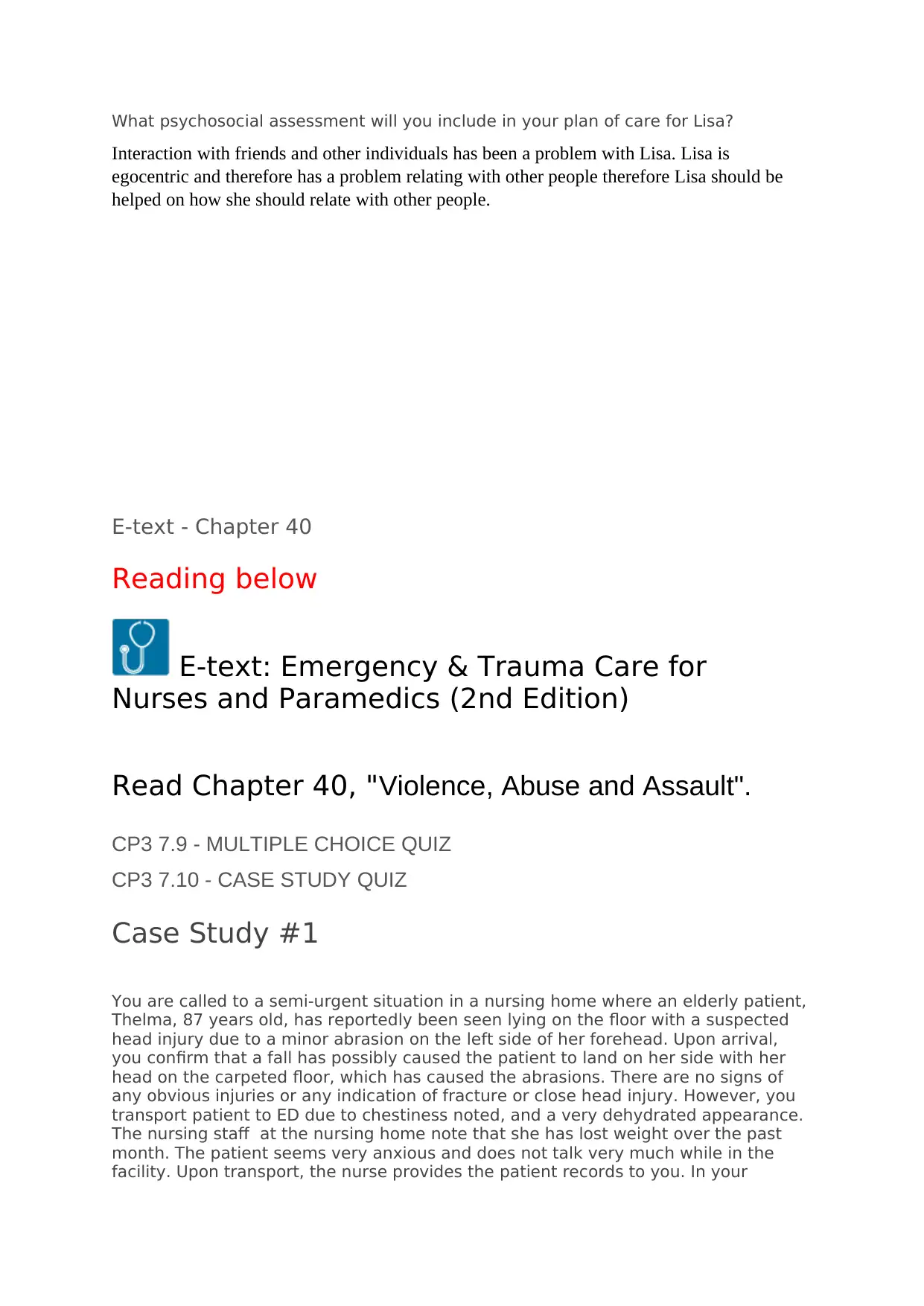
What psychosocial assessment will you include in your plan of care for Lisa?
Interaction with friends and other individuals has been a problem with Lisa. Lisa is
egocentric and therefore has a problem relating with other people therefore Lisa should be
helped on how she should relate with other people.
E-text - Chapter 40
Reading below
E-text: Emergency & Trauma Care for
Nurses and Paramedics (2nd Edition)
Read Chapter 40, "Violence, Abuse and Assault".
CP3 7.9 - MULTIPLE CHOICE QUIZ
CP3 7.10 - CASE STUDY QUIZ
Case Study #1
You are called to a semi-urgent situation in a nursing home where an elderly patient,
Thelma, 87 years old, has reportedly been seen lying on the floor with a suspected
head injury due to a minor abrasion on the left side of her forehead. Upon arrival,
you confirm that a fall has possibly caused the patient to land on her side with her
head on the carpeted floor, which has caused the abrasions. There are no signs of
any obvious injuries or any indication of fracture or close head injury. However, you
transport patient to ED due to chestiness noted, and a very dehydrated appearance.
The nursing staff at the nursing home note that she has lost weight over the past
month. The patient seems very anxious and does not talk very much while in the
facility. Upon transport, the nurse provides the patient records to you. In your
Interaction with friends and other individuals has been a problem with Lisa. Lisa is
egocentric and therefore has a problem relating with other people therefore Lisa should be
helped on how she should relate with other people.
E-text - Chapter 40
Reading below
E-text: Emergency & Trauma Care for
Nurses and Paramedics (2nd Edition)
Read Chapter 40, "Violence, Abuse and Assault".
CP3 7.9 - MULTIPLE CHOICE QUIZ
CP3 7.10 - CASE STUDY QUIZ
Case Study #1
You are called to a semi-urgent situation in a nursing home where an elderly patient,
Thelma, 87 years old, has reportedly been seen lying on the floor with a suspected
head injury due to a minor abrasion on the left side of her forehead. Upon arrival,
you confirm that a fall has possibly caused the patient to land on her side with her
head on the carpeted floor, which has caused the abrasions. There are no signs of
any obvious injuries or any indication of fracture or close head injury. However, you
transport patient to ED due to chestiness noted, and a very dehydrated appearance.
The nursing staff at the nursing home note that she has lost weight over the past
month. The patient seems very anxious and does not talk very much while in the
facility. Upon transport, the nurse provides the patient records to you. In your
⊘ This is a preview!⊘
Do you want full access?
Subscribe today to unlock all pages.

Trusted by 1+ million students worldwide
1 out of 16